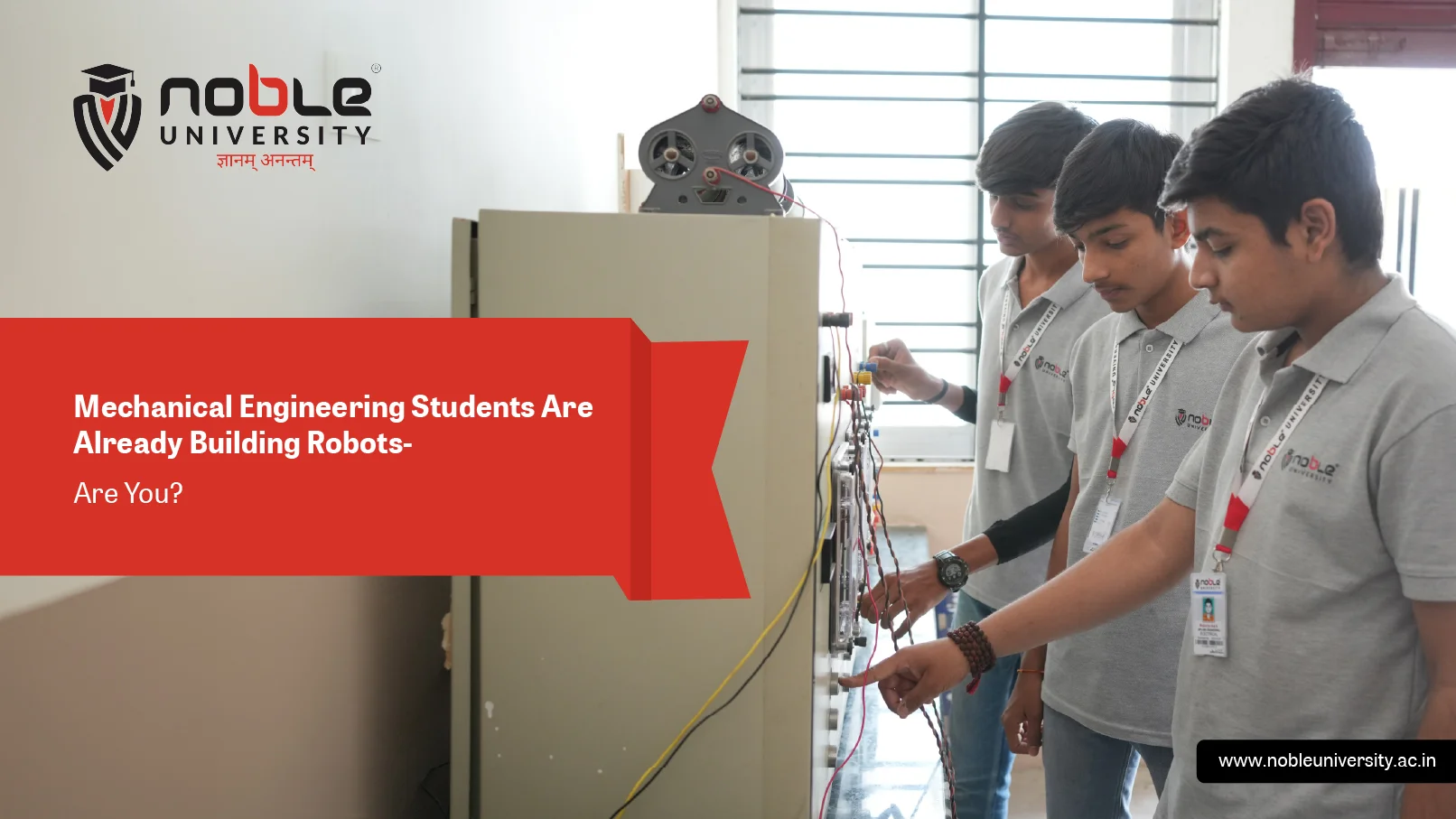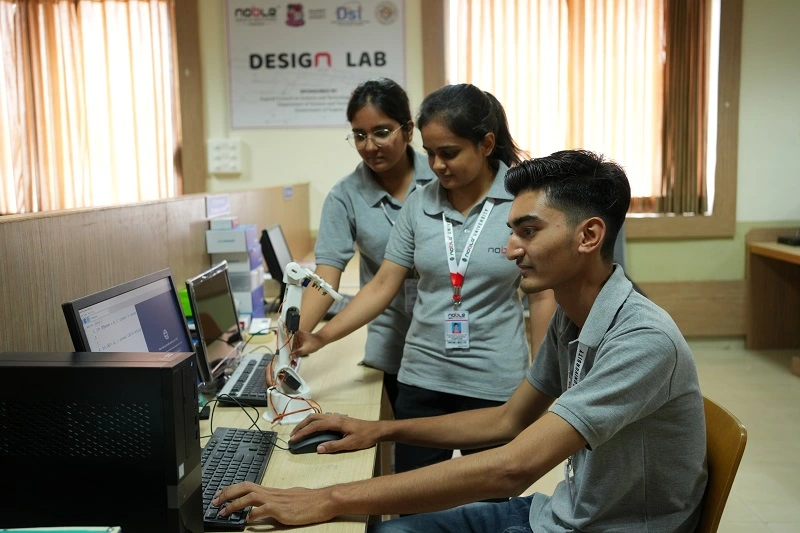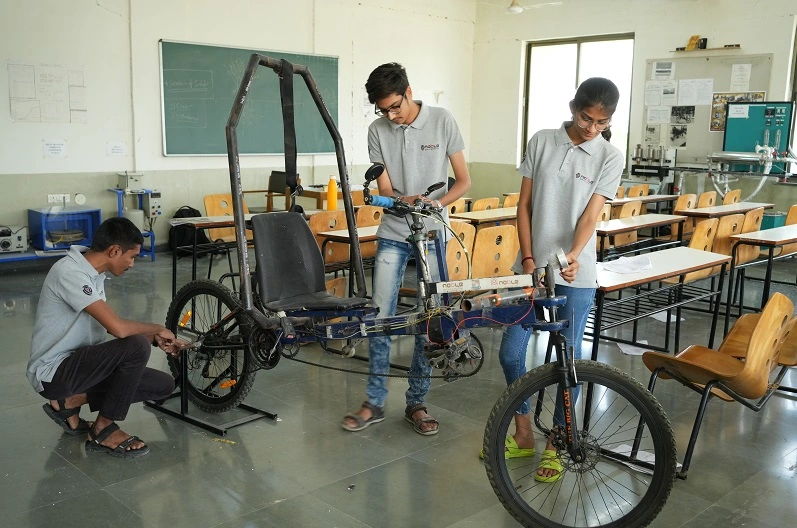
Can You Build a Robot in College? Projects to Try While Studying Mechanical Engineering in Junagadh
Have you ever dreamt of building your own robot? As a mechanical engineering student, you might think robotics is only for computer or electronics engineers. But in reality, mechanical engineering forms the core foundation of robotics, and yes, you can absolutely build a robot while studying in college.
Students often ask, Can mechanical engineering students build robots in college? The answer is a resounding yes. With the rise of interdisciplinary engineering, mechanical students now get hands-on exposure to mechatronics and robotics, which combine mechanics, electronics, and programming to create intelligent systems.

Why Should Mechanical Students Learn Robotics?
Here are three strong reasons:
- Practical Application of Concepts
Robotics helps you apply your knowledge of mechanics, design, materials, and manufacturing to build real systems. - Industry Demand
Automation and robotics are the future of manufacturing, automotive, aerospace, and biomedical sectors. Mechanical engineers with robotics skills are highly valued. - Enhances Problem-Solving Skills
Building robots makes you think like an engineer – identifying problems, designing solutions, and testing prototypes.
How Does Robotics Tie Into Mechanical Engineering?
Robotics is an interdisciplinary field that blends:
- Mechanical Engineering: Design of robot structure, joints, gears, and movement mechanisms.
- Electrical/Electronics Engineering: Wiring, circuits, sensors, and actuators.
- Computer Engineering: Coding the robot’s brain to perform tasks.
For example, when building a robotic arm, mechanical engineers design the frame, joints, and linkages; electronics students integrate sensors and motors; programmers code its movements. As a mechanical engineer, you play a vital role in designing and fabricating the physical system.

Beginner Robotics Projects for Mechanical Engineers
If you are wondering how to build a robot in college, start with these simple yet powerful projects:
1. Line Following Robot
- What it is: A robot that follows a path marked on the floor using IR sensors.
- What you learn: Basics of chassis design, motor control, sensor integration, and simple programming.
- Tools needed: Arduino board, IR sensors, DC motors, motor driver module, wheels, chassis kit.
2. Obstacle Avoidance Robot
- What it is: A robot that detects obstacles and changes its path to avoid collisions.
- What you learn: Ultrasonic sensor usage, mechanical mounting, and programming for navigation.
- Tools needed: Arduino, ultrasonic sensor (HC-SR04), motor driver, wheels, chassis.
3. Robotic Arm
- What it is: A stationary arm with joints that can pick and place objects.
- What you learn: Mechanism design, linkage systems, servo motors, and control programming.
- Tools needed: Servo motors, Arduino, mechanical arm kit, or custom-fabricated parts.
4. Bluetooth Controlled Car
- What it is: A robot car controlled using your smartphone via Bluetooth.
- What you learn: Wireless communication, motor interfacing, chassis design, and app integration.
- Tools needed: Arduino, Bluetooth module (HC-05), motor driver, DC motors, wheels, chassis.
5. Gesture-Controlled Robot
- What it is: A robot that moves based on hand gestures using an accelerometer.
- What you learn: Sensor interfacing, wireless control, and mechanical stability considerations.
- Tools needed: Arduino, accelerometer sensor (like ADXL345), motor driver, wireless modules.
How to Start Building Robots as a Mechanical Student
Here is your step-by-step guide:
- Learn Basic Electronics & Programming
Understanding Arduino programming (C/C++) and circuit basics is essential. - Get a Robotics Kit
Robotics kits for students are easily available online with Arduino boards, sensors, motors, and chassis parts. - Join Robotics Clubs or Workshops
Participate in college robotics clubs and workshops in Junagadh to gain team experience and guidance. - Start Small
Begin with simple projects like line followers or obstacle avoiders before moving to complex systems like robotic arms. - Collaborate with Other Branches
Work with electronics and computer engineering students for integrated projects. - Upgrade Your Skills
Explore mechatronics, automation, CAD designing, and 3D printing to build advanced robots.

Robotics Kits for Students: What to Buy?
For college-level beginner projects, invest in:
- Arduino UNO starter kit
- Sensor kits (IR, ultrasonic, accelerometer)
- Motor driver modules (L298N)
- DC motors, servo motors, wheels
- Chassis frames or sheet metal to build your own
- Basic tools: Screwdrivers, soldering iron, jumper wires, breadboards.
Learn Hands-On Robotics at Noble University’s Robonob Cell
If you’re a student in Junagadh dreaming of building robots, designing automation systems, or just getting your hands dirty with real-world technology, you don’t have to look far. Noble University offers an exciting, student-driven platform called the Robonob Cell—a space where innovation, creativity, and engineering come alive.
So, what exactly is the Robonob Cell?
Robonob is the robotics innovation cell of Noble University under its Entrepreneurship Development Cell (EDC). It’s not just a club—it’s a launchpad for ideas and experiments in the field of robotics, embedded systems, and automation.
Here’s what students can do at the Robonob Cell:
- Design and Build Robots: Students work on actual robotics projects—from line-followers and gesture-controlled bots to advanced prototypes.
- Hands-On Training: Workshops and sessions are conducted regularly to help students understand and work with microcontrollers, sensors, and IoT devices.
- Team-Based Learning: It’s a collaborative space where students team up, share ideas, and build projects together, just like in real tech startups.
- Innovate for Competitions: The cell encourages participation in national-level tech fests, hackathons, and innovation challenges.
- Mentorship and Support: Faculty members and technical experts guide students throughout the ideation, design, and execution phases.
For students in Junagadh and surrounding areas, the Robonob Cell at Noble University is one of the few places offering structured, campus-level exposure to robotics. It’s not just about theory—it’s about solving real problems with technology and developing the confidence to build something from scratch.
Mechanical Engineering Projects in Robotics
At Noble University, mechanical students have successfully completed robotics-based projects like:
- Autonomous floor cleaning robots
- Agriculture seed sowing robots
- Solar-powered robotic cars
- Pick-and-place robotic arms for assembly lines
- Robotic grippers using pneumatics and hydraulics
- Arduino-based robotic vehicles for transportation studies
These projects combine mechanical design, fabrication, electronics integration, and programming, giving students full-stack engineering exposure.
The Future is Robotic – Are You Ready?
Robotics is no longer just a hobby. It is the future of every core industry. Mechanical engineers who learn robotics and automation during college become industry-ready professionals with a strong edge in placements and higher studies.
At Noble University, we encourage students to innovate beyond textbooks through:
- Robotics workshops and training sessions
- Dedicated robotics and mechatronics labs
- Interdisciplinary projects with computer and electrical students
- Mentoring for national robotics competitions
Ready to build your first robot?
Explore mechanical engineering programs at Noble University, Junagadh to gain the skills, facilities, and mentorship needed to bring your robotic innovations to life.
FAQS
Absolutely! Mechanical engineering students can build robots by applying their knowledge of design and mechanics, along with basic electronics and programming. It’s a great way to combine theory with hands-on innovation.
Some beginner-friendly robotics projects include line-following robots, obstacle-avoiding robots, robotic arms, Bluetooth-controlled cars, and gesture-controlled robots. These projects help build foundational skills in both hardware and control systems.
Yes, they do. Prominent institutions like Noble University provide access to well-equipped robotics labs and organize regular workshops through initiatives like the Robonob Cell to help students gain practical experience.
To get started, you’ll need components like Arduino kits, sensors, DC motors, chassis frames, motor driver modules, and some basic programming skills. These are the building blocks of most student-level robotics projects.
Robotics heavily relies on mechanical engineering principles. Mechanical engineers are responsible for designing the robot’s structure, joints, and movement mechanisms, making it a perfect interdisciplinary field for them to explore.


